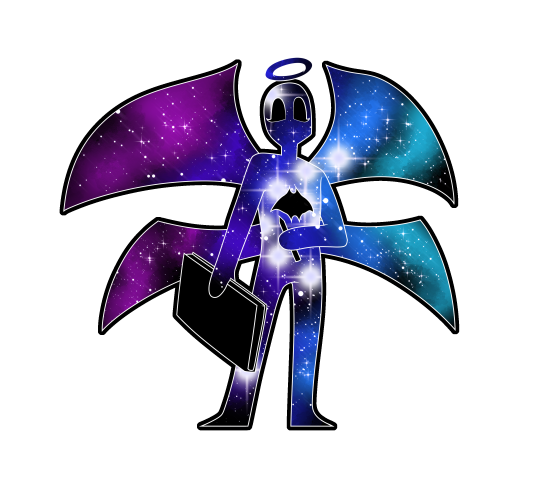#yammu
Text

Yam, the ancient Semitic deity of the sea and water. Yam was born of the Divine couple El and Asherah, making him the brother of the main pantheon of deities. Yam’s most important role was that of Baal’s rival. Their rivalry was sparked as the two were competitors for the title of king of the gods. However at first Yam held more influence than Baal, having the favor of both El and Asherah. Yam at the height of his power shows disrespect to the other gods including his father El. Eventually Baal and Yam agreed to a duel in which the loser would pull out of the competition for the king of the gods. Yam eventually gains the upper hand, but with the help or encouragement of his wives Anat and Astarte, Baal is revitalized and defeates Yam.
Yam has been one of the most influential deities to exist. His presence is echoed across a vast majority of Eurasian mythologies. From the myth of Indra fighting Vritra, to Perun fighting Veles, all of them are believed to have stemmed from a memory of Yam’s battle with Baal. Even Tiamat owes her origin to Yam. Yam has even left a trace in monotheistic religions, as the Climate Beast Leviathan of Abrahamic faiths is a direct successor to Yam. Despite Yam being distinctly a Semitic deity, he was also attested in Egyptian myths. In Egypt his rival was Set who was conflated with Yam’s original rival Baal. Yam held many other names and titles, such as Nahar meaning “river”. Yam’s original name however comes from the Ugaritic word for the Sea.
#art#character design#mythology#creature design#yam#yammu#semitic mythology#semitic#canaan#canaanite mythology#water god#sea god#monster#deity
12 notes
·
View notes
Text
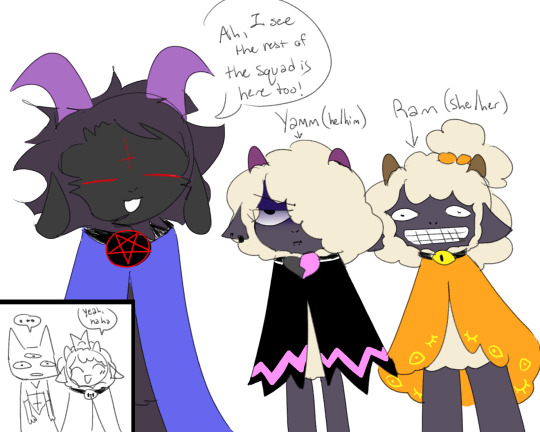
The Debt 6 (Day 68)
#dailynarilamb#the debt#black phillip#yamm dnl#ram dnl#sequel to the lamb triplets ask#this is what the others look like when they aren't pretending to be Lambert#Yamm's full name is Yammu and Ram's is Ramilynne#and lamb's text was pink in the triplet's ask because Lamb and Yamm swapped text colors to make it extra hard for narinder
28 notes
·
View notes
Text

Who is Levi?
Leviathan, Hebrew Livyatan, in Jewish mythology, a primordial sea serpent. Its source is in prebiblical Mesopotamian myth, especially that of the sea monster in the Ugaritic myth of Baal (see Yamm). In the Old Testament, Leviathan appears in Psalms 74:14 as a multiheaded sea serpent that is killed by God and given as food to the Hebrews in the wilderness. In Isaiah 27:1, Leviathan is a serpent and a symbol of Israel’s enemies, who will be slain by God. In Job 41, it is a sea monster and a symbol of God’s power of creation
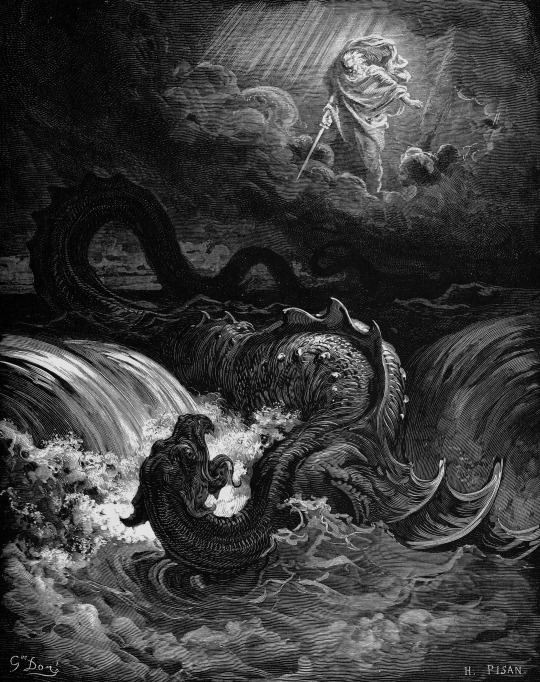
Etymology:
Gesenius (among others) argued the name לִוְיָתָןwas derived from the root לוה lwh "to twine; to join", with an adjectival suffix ן- ָ, for a literal meaning of "wreathed, twisted in folds". If it exists, the adjectival suffix ן- ָ (as opposed to -ון) is otherwise unattested except perhaps in Nehushtan, whose etymology is unknown; the ת would also require explanation, as Nechushtan is formed from neḥšoeṯ and Leviathan from liveyah; the normal-pattern f.s. adjective would be לויון, liveyon. Other philologists, including Leskien, thought it a foreign loanword. A third school considers it a proper noun. Bauer proposed לוית+תן, for "wreath of serpent."
Both the name and the mythological figure are a direct continuation of the Ugaritic sea monster Lôtān, one of the servants of the sea god Yammu defeated by Hadad in the Baal Cycle. The Ugaritic account has gaps, making it unclear whether some phrases describe him or other monsters at Yammu's disposal such as Tunannu (the biblical Tannin). Most scholars agree on describing Lôtān as "the fugitive serpent" (bṯn brḥ) ,but he may or may not be "the wriggling serpent" (bṯn ʿqltn) or "the mighty one with seven heads" (šlyṭ d.šbʿt rašm). His role seems to have been prefigured by the earlier serpent Têmtum whose death at the hands of Hadad is depicted in Syrian seals of the 18th–16th century BC.

Mythology:
Sea serpents feature prominently in the mythology of the ancient Near East. They are attested by the 3rd millennium BC in Sumerian iconography depicting the god Ninurtaovercoming a seven-headed serpent. It was common for Near Eastern religions to include a Chaoskampf: a cosmic battle between a sea monster representing the forces of chaos and a creator god or culture hero who imposes order by force. The Babylonian creation myth describes Marduk's defeat of the serpent goddess Tiamat, whose body was used to create the heavens and the earth.
—all art was found via Google, it doesn’t not belong to me, but to the artist who created it. If you see any art depicted on my channel that is yours and you do not want it shared, just tell me, I’m on your side ^_^-
#obey me#obey me shall we date#obey me leviathan#obey me!#obey me demonology#obey me origins#3rd husband
87 notes
·
View notes
Text
So who is Baal?
Baal or Baʻal, was a title and honorific meaning 'owner', 'lord' in the Northwest Semitic languages spoken in the Levant during antiquity.
Baal is a God of fertility, weather, rain, wind, lightning, seasons, war, sailors and so on.
Baal worship is also called Baalism.

Solid cast bronze of a votive figurine representing the god Baal discovered at Tel Megiddo, dating to the mid-2nd millennium BC.
His holy symbols are bull, ram and thunderbolt.
Baal was worshipped in ancient Syria, especially Halab, near, around and at Ugarit, Canaan, North Africa and Middle Kingdom of Egypt.
Baʿal is well-attested in surviving inscriptions and was popular in theophoric names throughout the Levant but he is usually mentioned along with other gods, "his own field of action being seldom defined". Nonetheless, Ugaritic records show him as a weather god, with particular power over lightning, wind, rain, and fertility. The dry summers of the area were explained as Baʿal's time in the underworld and his return in autumn was said to cause the storms which revived the land. Thus, the worship of Baʿal in Canaan—where he eventually supplanted El as the leader of the gods and patron of kingship—was connected to the regions' dependence on rainfall for its agriculture, unlike Egypt and Mesopotamia, which focused on irrigation from their major rivers. Anxiety about the availability of water for crops and trees increased the importance of his cult, which focused attention on his role as a rain god. He was also called upon during battle, showing that he was thought to intervene actively in the world of man, unlike the more aloof El. The Lebanese city of Baalbeck was named after Baal.
The Baʿal of Ugarit was the epithet of Hadad but as the time passed, the epithet became the god's name while Hadad became the epithet. Baʿal was usually said to be the son of Dagan, but appears as one of the sons of El in Ugaritic sources. Both Baʿal and El were associated with the bull in Ugaritic texts, as it symbolized both strength and fertility. He held special enmity against snakes, both on their own and as representatives of Yammu (lit. "Sea"), the Canaanite sea god and river god. He fought the Tannin (Tunnanu), the "Twisted Serpent" (Bṭn ʿqltn), "Lotan the Fugitive Serpent" (Ltn Bṭn Brḥ, the biblical Leviathan), and the "Mighty One with Seven Heads" (Šlyṭ D.šbʿt Rašm). Baʿal's conflict with Yammu is now generally regarded as the prototype of the vision recorded in the 7th chapter of the biblicalBook of Daniel. As vanquisher of the sea, Baʿal was regarded by the Canaanites and Phoenicians as the patron of sailors and sea-going merchants. As vanquisher of Mot, the Canaanite death god, he was known as Baʿal Rāpiʾuma (Bʿl Rpu) and regarded as the leader of the Rephaim (Rpum), the ancestral spirits, particularly those of ruling dynasties.
From Canaan, worship of Baʿal spread to Egypt by the Middle Kingdom and throughout the Mediterranean following the waves of Phoenician colonization in the early 1st millennium BCE. He was described with diverse epithets and, before Ugarit was rediscovered, it was supposed that these referred to distinct local gods. However, as explained by Day, the texts at Ugarit revealed that they were considered "local manifestations of this particular deity, analogous to the local manifestations of the Virgin Mary in the Roman Catholic Church". In those inscriptions, he is frequently described as "Victorious Baʿal" (Aliyn or ẢlỈyn Baʿal), "Mightiest one" (Aliy or ʿAly) or "Mightiest of the Heroes" (Aliy Qrdm), "The Powerful One" (Dmrn), and in his role as patron of the city "Baʿal of Ugarit" (Baʿal Ugarit). As Baʿal Zaphon (Baʿal Ṣapunu), he was particularly associated with his palace atop Jebel Aqra (the ancient Mount Ṣapānu and classical Mons Casius). He is also mentioned as "Winged Baʿal" (Bʿl Knp) and "Baʿal of the Arrows" (Bʿl Ḥẓ). Phoenician and Aramaic inscriptions describe "Baʿal of the Mace" (Bʿl Krntryš), "Baʿal of the Lebanon" (Bʿl Lbnn), "Baʿal of Sidon" (Bʿl Ṣdn), Bʿl Ṣmd, "Baʿal of the Heavens" (Baʿal Shamem or Shamayin), Baʿal ʾAddir (Bʿl ʾdr), Baʿal Hammon (Baʿal Ḥamon), Bʿl Mgnm.
The epithet Hammon is obscure. Most often, it is connected with the NW Semitic ḥammān ("brazier") and associated with a role as a sun god. Renan and Gibson linked it to Hammon (modern Umm el-‘Amed between Tyre in Lebanon and Acre in Israel) and Cross and Lipiński to Haman or Khamōn, the classical Mount Amanus and modern Nur Mountains, which separate northern Syria from southeastern Cilicia.
The major source of our direct knowledge of this Canaanite deity comes from the Ras Shamra tablets, discovered in northern Syria in 1958, which record fragments of a mythological story known to scholars as the Baal Cycle. Here, he earns his position as the champion and ruler of the gods. The fragmentary text seems to indicate a feud between him and his father El as background. El chooses the fearsome sea god Yam to reign as king of the gods. Yam rules harshly, and the other deities cry out to Ashera, called Lady of the Sea, to aid. Ashera offers herself as a sacrifice if Yam will ease his grip on her children. He agrees, but Baal opposes such a scheme and boldly declares he will defeat Yam even though El declares that he must subject himself to Yam.
With the aid of magical weapons given to him by the divine craftsman Kothar-wa-Khasis, Baal defeats Yam and is declared victorious. He then builds a house on Mount Saphon, today known as Jebel al-Aqra. (This mountain, 1780 meters high, stands only 15 km north of the site of Ugarit, clearly visible from the city itself.)
Lo, also it is the time of His rain.
Baal sets the season,
And gives forth His voice from the clouds.
He flashes lightning to the earth.
As a house of cedars let Him complete it,
Or a house of bricks let Him erect it!
Let it be told to Aliyan Baal:
'The mountains will bring Thee much silver.
The hills, the choicest of gold;
The mines will bring Thee precious stones,
And build a house of silver and gold.
A house of lapis gems!'
However, the god of the underworld, Mot, soon lures Baal to his death, spelling ruin for the land. His sister Anat retrieves his body and begs Mot to revive him. When her pleas are rebuffed, Anat assaults Mot, ripping him to pieces and scattering his remains like fertilizer over the fields.
El, in the meantime, has had a dream in which fertility returned to the land, suggesting that Baal was not indeed dead. Eventually he is restored. However, Mot too has revived and mounts a new attack against him.
They shake each other like Gemar-beasts,
Mavet [Mot] is strong, Baal is strong.
They gore each other like buffaloes,
Mavet is strong, Baal is strong.
They bite like serpents,
Mavet is strong, Baal is strong.
They kick like racing beasts,
Mavet is down. Baal is down.
After this titanic battle, neither side has completely prevailed. Knowing that the other gods now support Baal and fearing El's wrath, Mot finally bows before him, leaving him in possession of the land and the undisputed regent of the gods.
Baal is thus the archetypal fertility deity. His death signals drought and his resurrection, and brings both rain and new life. He is also the vanquisher of death. His role as a maker of rain would be particularly important in the relatively arid area of Palestine, where no mighty river such as the Euphrates or the Nile existed.
#baal#baal deity#baalism#canaanite gods#canaan#ancient history#ancient gods#history#ancient god#spiritual#deity#deities#religious#religion#religia#ancient religion#ancient world#gods#myth#mythos#ancient myths#mythology#mythology and folklore#myths#Canaanite religion#world religions#world history#ancient mythology
14 notes
·
View notes
Text
These are the winners of the MyAnimeList x Honeyfeed Writing Contest 2023!
We're pleased to unveil the winners of the MyAnimeList x Honeyfeed Writing Contest 2023!
Let's give a roaring round of applause to:

Just_Another_Adult with “VISUAL SHOCK - sometimes you have to promise not to fall in love~” for winning the Present-Day Cup!
Yammu with “The Songstress of Avalon” for winning the Isekai Cup!
Armonia with “Telling the Bees” for winning the Runner-up Cup!
A huge thank you to everyone who submitted their novels to this contest! We hope this experience fuels your passion, inspiring you to elevate your writing goals to new heights.
If you missed the contest this year, be sure to check back with Honeyfeed, as we'll continue to host many more writing contests and events in the near future. Until next time!
6 notes
·
View notes
Photo


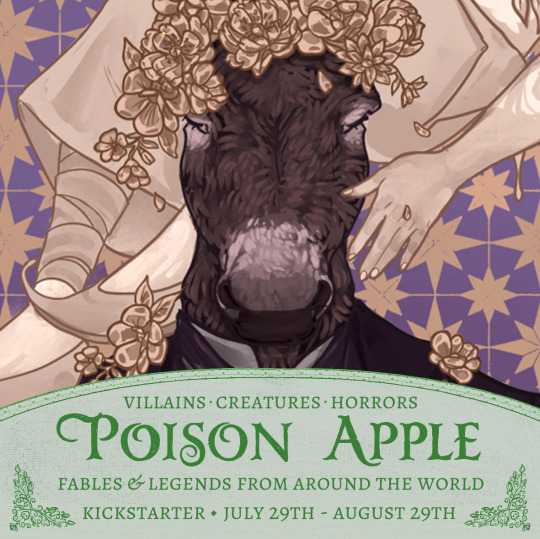
Poison Apple preorders close in 2 days!! 🍏
Visit our kickstarter page before preorders end on Monday August 29th - We have digital editions, hardcover zines, tarot decks, and a beautiful collection of merch pieces.
🍎 KICKSTARTER PAGE 🍎
Tarot previews by
yammu
@sirswamp
@zephyrbug
33 notes
·
View notes
Text
1-KING BA'EL
Enn:Ayer Secor On Ca Ba'el


Other names: Baal, Beelzebub
King Bael for beginner to advanced practitioners. He rules over solstices and fire festivals and can bring together friends. He can spark creativity and instruct people in matters of the heart. If you seek him for wealth, let it be in creative wealth or wealth created by creative projects. It is suggested you wear his sigil when invoking him. he is a spirit of shape shifting and can help you shapeshift in your dreams. He is a powerful familiar spirit who may bring one much instinctual impulses in relation to animals and dream shape shifting. He brings strength and influence over people, though not through wit or wisdom.
Ba'al
Ba'al (Hebrew:בַּעַל) the god of fertility, weather, rain, wind, lightning, seasons, war, sailors. His symbol is of the bull, ram, and thunderbolt. His Greek equivalent was Zeus and his Egyptian equivalent was Set, Horus. The Baʿal of Ugarit was the epithet of Hadad but as the time passed, the epithet became the god's name while Hadad became the epithet. Baʿal was usually said to be the son of Dagan, but appears as one of the sons of El in Ugaritic sources. Both Baʿal and El were associated with the bull in Ugaritic texts, as it symbolized both strength and fertility. He held special enmity against snakes, both on their own and as representatives of Yammu (lit. "Sea"), the Canaanite sea god and river god. He fought the Tannin (Tunnanu), the "Twisted Serpent", "Lotan the Fugitive Serpent", and the "Mighty One with Seven Heads". Baʿal's conflict with Yammu is now generally regarded as the prototype of the vision recorded in the 7th chapter of the biblical Book of Daniel. As vanquisher of the sea, Baʿal was regarded by the Canaanites and Phoenicians as the patron of sailors and sea-going merchants. As vanquisher of Mot, the Canaanite death god, he was known as Baʿal Rāpiʾuma and regarded as the leader of the Rephaim, the ancestral spirits, particularly those of ruling dynasties.
Beelzebub
Beelzebub (baalzebub, beelzebul) said to be a prince of hell and rules over envy and gluttony. The Dictionnaire Infernal describes Beelzebub as a being capable of flying, known as the "Lord of the Flyers", or the "Lord of the Flies". In the Testament of Solomon is an Old Testament pseudepigraphical work, purportedly written by King Solomon, in which the author mostly describes particular demons whom he enslaved to help build Solomon's Temple, with substantial Christian interpolations. Beelzebul (not Beelzebub) appears as prince of the demons and says that he was formerly a leading heavenly angel who was associated with the star Hesperus. Seemingly, Beelzebul here is synonymous with Lucifer. Beelzebul claims to cause destruction through tyrants, to cause demons to be worshipped among men, to excite priests to lust, to cause jealousies in cities and murders, and to bring about war.
Call upon King Bael for
⬩Instructions in the matter of the heart
⬩Invisibility (to be noticed less by others)
⬩Fertility
⬩Shape Shifting in dreams
⬩Sparking creativity
⬩Storms
⬩Wealth
⬩Ask him what else he's willing to work with you on⬩
⊱•━━━━━━⊰In Ritual⊱━━━━━•⊰
You can use
Enn:Ayer Secor On Ca Ba'el
Sigil:posted above
Plant:Fern
Incense: Frankincense
⬩Yellow/black candles or objects
⬩Do ask King Bael yourself what he likes⬩
in my experience he likes the incense frankincense and Sandalwood, I use frog/toad/ and cat items to represent him on my altar.
⬩It is important to learn protections before trying to work with any spirits. You can get tricksters and parasites if you don't.
Cleansings- cleaning your space of negative energies. You can burn herbs or incense for this.
Banishings- forcing negative energies out of your space. The lesser banishing ritual is one of the most commonly used.
Warding- wards keep negative energy out of your space. Amulets, sigils and talismans do this.
Set up a your space and do a cleanse and banishing. Have wards up in your home. Meditation is to calm yourself and get your mind ready. The sigil (symbol) is what you draw on paper. The enn is what you chant or say to call forth the spirit.⬩
48 notes
·
View notes
Text
"The Dánavas, Danaans, Danes, and people of the goddess Danu designate mythic / epic or real tribes, thus it seems probable that at least in some of these names deh2nu- / *dhonu- has been conflated with an ancient homophonic ethnonym Danu. The myths under consideration are associated with the origins of the peoples (cf. e.g. the eponymous figures of Hayk, Danaos, Danu), and moreover, the ethnic identities of the *h2ner-s are formed as a result of their conflict with the Danus. In these myths, as it seems, the great god of the Semites, represented as the negative mirror-image of the Indo-European divine heroes, replaced the figure of the mythic adversary of the original myth (cf. the figure of Vrtra, Dánava, serpent, ruler of the otherworld, adversary of the thunder god Indra in the Vedic myth). These myths would have been formed as a result of contacts between the Indo-Europeans and the Semites (which figure as the Danu clan, under command of the god B‘l),6 and then passed to the other regions of the Indo-European world. Elements of these myths are comparable with the (West) Semitic myths of Marduk and Baal (cf. Dexter 1990: 54-55). Moreover, some West Semitic mythological motifs and names are reminiscent of those of the Indo-European myths: the thunder god Baal slew the “judge/lord (of) river” Yammu ‘Sea’ and the dragon, Tannîn; the eponymous forefather of the North Syrian state of Ugarit was Ditanu / Didanu (Shifman 1987: 73-74, 90-91, cf. the figures of Dánu and Bel the Titanid)...
According to V.V. Ivanov and S.A. Starostin, in West Semitic there is a significant layer of Indo-European borrowings (Ivanov 2004: 45-46; the special study of Starostin, to the best of my knowledge, is not yet published). These borrowings are considered in the context of the theory of the original home of the Indo-Europeans in the south of the Armenian Highland and north of Mesopotamia and Syria. Irrespective of the location of the Indo-European homeland, the early contacts between the Indo-Europeans and West Semites could have occurred in those territories. Judging from the myths, some Indo-Europeans neighbored the West Semites and even could have been merged with them.
Armen Petrosyan, The Indo-European *H2ner(t)-s and the Dānu tribe
4 notes
·
View notes
Photo

Yammer looking at a flyer of the painting exhibition by Chiaki Kadota. The oil painting of Yammu has been exhibited at the solo show of Chiaki, which has just inaugurated in Hayama, Japan. Open through 29th JAN! #painting of #yammer , the #cat from #india at the solo #exhibition by #chiakikadota #kasper #gallery #hayama #japan #photozushihayama (at Bookshop Kasper) https://www.instagram.com/p/CnqsOmLSR_LjXNN90o09A19NFnzp8JEGInm9TI0/?igshid=NGJjMDIxMWI=
2 notes
·
View notes
Text
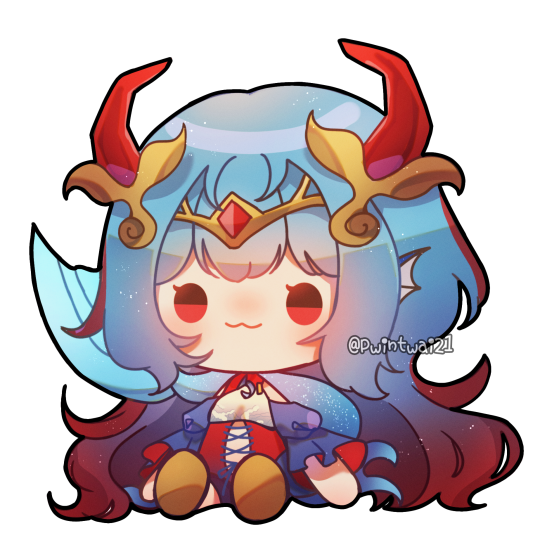
Smug plushie Yammu will keep you company whilst you work!
I've been working on uni a lot recently. What are you all working on?
Can't wait to hang out together again. Until then, This plush Yammu has to suffice.
Art by @Pwintwai21
2 notes
·
View notes
Text

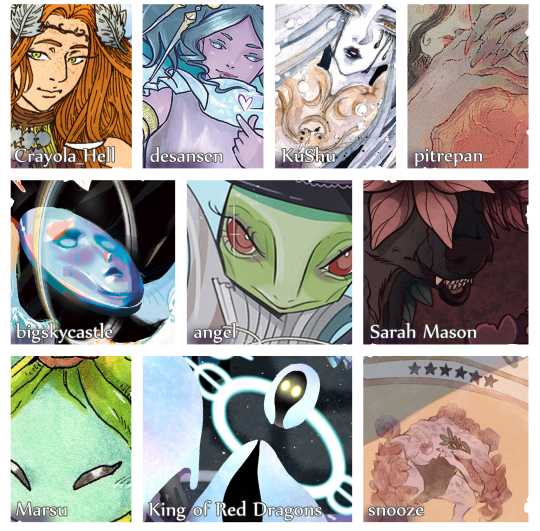

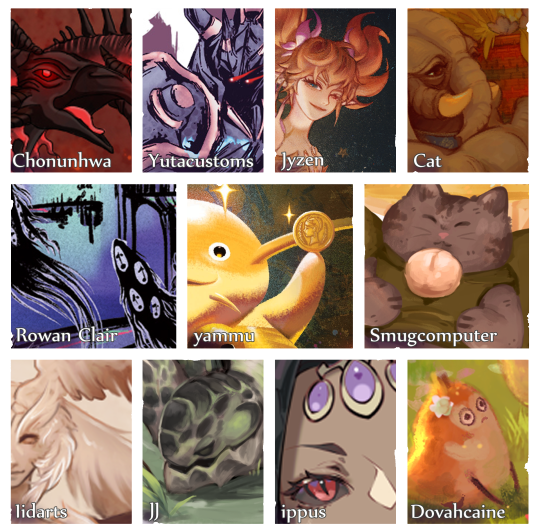

🐥PRE-ORDERS CLOSE TODAY🐥
Untamed 2 is a celebration of the creatures of FFXIV & features a group of stellar creators who put so much love & heart into their pieces 💛
Follow all the talented creators involved and be sure to secure your pre-order to get the unlocked stretch goals for free!
ORDER NOW
--
@inktho | @casseabun | Cham | @linno-doodle | @42wv | Crayola_Hell | @desansen | KuShu | @pitrepan | @bigskycastle | @sabattons | Sarah Mason Art | @peculiarmarsu | @kingofreddragons | @snoozedraws | @ooowyn | @amaretta | @whitecatarts | Sei | @whispyart | @4threset | Trina Zabel | @nyansarts | @sierrasketches | @apric0tfield | @chonunhwa-illustrator | Yutacustoms | @elvrenor | @ababblesaurus | @rowanclair | yammu | @smugcomputer | iidarts | @aishishiii | ippus | @dovahcaine | @athena-ishnuala | @loyaltykink | @destiny-islanders | @lextheglider | @egguv | @thatfirstspark | @xygdrasil | Morgan | @januarywren | Breann Ortega-Roberts | @winterune | Augustin Andre |
42 notes
·
View notes
Text
staring into the eyes of a senile sockeye at the banks of a stagnant stream.
2 notes
·
View notes
Note
hi chierry! i’m currently reading khr and i wanna talk about it with someone but why do you think tyl-tsuna confided his plans to hibari when he didn’t even tell gokudera and yamamoto? i have always found this super interesting so i wanted to ask your opinion too 🙈 (i wish he had seen more of everyone ten-years-later 😭😭😭, khr has so much potential it really pains me that it ended the way it did)
Hi anon!
My personal theory on that is that Hibari was the perfect combination of several factors that other guardians might have, but not all at once.
1. The number one reason I think is that Hibari is simply insane in the best way possible. If Yamamoto or Gokudera heard Tsuna saying he would fake his own death the plan simply would have gotten scrapped because they are NOT accepting this. And if they DID, I don't doubt that the guilt of seeinf everyone grieve Tsuna would make them REAAAALY hurt. I don't think they would reveal anything, but simply they wouldn't be able to take it without a lot of damage. Hibari tho? I am not discarting the friendship he has cultivated with everyone in the future nor his feelings, but he would take it better than Yammu/Goku.
2. Hibari is REALLY hard to get information about. Both meta-wise and canon-wise. This plan could NOT work if anyone else other than Tsuna, Irie and Hibari knew about it. Everyone in the Vongola has a semblance of a past and family to serve as possible hostages in exchange for information, but Hibari? We legit don't know if he even has family. King of keeping his private life and work life separated. Pairing that with the fact that he is also a MIST now, it's straight up miracle work to get a hold of him if he doesn't want you to. With that, Tsuna didn't have to worry about any outside influences or enemies getting this information, probably not even Tsuna himself has a fool-proof method of getting to him lmao
3. Going back to the insane point, he is insane enough and smart enough to hear the kind of time-travelling BS Irie and Tsuna came up with and just go... Fine. Give me two real good fights and I'm in. I think that Gokudera could take the infomration well, but again, emotionally he wouldn't be able to take it for too long, and let's be real, Tsuna was ALREADY abusing their feelings there. He prob also didn't want to pile up those feelings even more.
4. It's not weird for Hibari to just be on his own. Wich means that he can be prepping A LOT of shit for this plan and nobody would suspect. Let's say, Yamamoto is missing for 4 months? Mh, weird... not out of the question considering their line of work but weird. Hibari missing for 8 months? Lil rascal is prob in one of his many mansions chilling. I feel like this privacy gives him an edge that is perfect for prepping for a super-secret plan with little suspicion.
5. (SPOILERS FOR SIMON ARC) Hibari has said he feels some kind of gratitude for Tsuna, and I don't doubt that this feeling grows in the future. Paired with all that above, I feel like Tsuna just legit felt like if Hibari was the one helping with it, he wouldn't fuck it up. That mutual trust thing going on you know?
6. uh this point is kind of stupid but he probably has counting on Hibari being able to go full-on nuclear in case everything else failed lmao
7. I think that, meta-wise, Amano wanted to show that Hibari, for as much as he denies being part of the group, still very much got attached to being a Guardian.
TLDR: I think that the emotional pain it would bring other guardians + his aloofness + his power + his relationship with Tsuna was the perfect storm to make him be the perfect choice.
(and don't tell me, I would legit kill for a future-only arc!! I LOVE LOVE seeing them grow and a good chunk of my mental space is dedicated for thinking the kind of adventures they go now. Like, please, the angst? the relationships? THE POWERS? THE A N GS T you have no idea how right you are anon. We were robbed of an arc of them being adults and I will forever cry obver the potential
66 notes
·
View notes
Photo

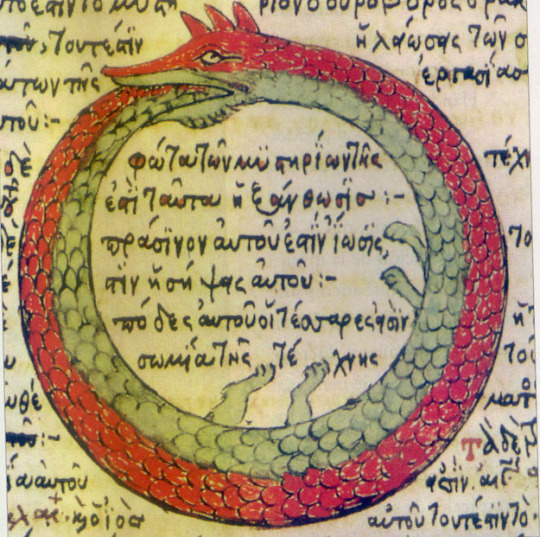
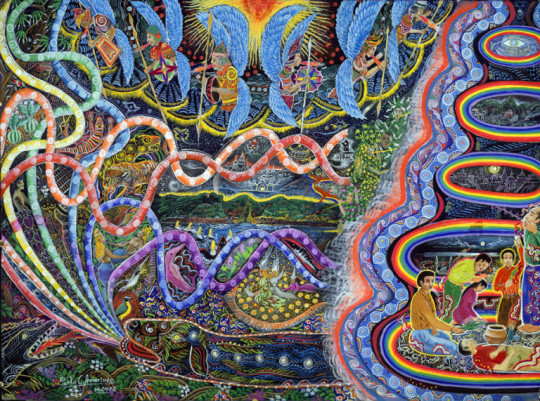

Ermengand/Jörmungandr
The Ermengand is the Dutch name for the famous sea serpent who is known as the Jörmungandr in old Norse. The name Ermengand comes from the proto-Germanic word 'Ermunagandaz'. A composition of the words ermunaz which means big and gandaz which means either snake or sorcery. This gigantic serpent lives in, what the Dutch call, the Wendelzee (which is the sea that surrounds middle earth. (No not that middle earth...)
Who is Jörmungandr/Ermengand exactly? The Ermengand/Jörmungandr has the appearance of a gigantic serpent but he is the son of Loki and the giant Angrboda according to old Norse sources. Jörmungandr has a brother and a sister, the wolf Fenrir and Goddess of the underworld Hel. Jörmungandr lives in the oceans surrounding midgard, seemingly peacefully until Ragnarok. Although there are indications that the Germanics believed Jörmungandr's movements are responsible for earthquakes.
The concept of a sea serpent is present in many different mythologies. The ancient Mesopotamians and Babylonians were familiar with a sea serpent. The ancient Babylonians had Tiamat, the Mesopotamians had Marduk and the Phoenicians had the Leviathan. Note that Marduk, Leviathan and Tiamat are all names of Satan's highest ranking servants according to the Abrahamic religions.
The classic story of a hero battling a giant sea snake is also ancient and visible in several mythologies. The Canaanites, an ancient civilization often named in the bible, believed in the Baal cycle. The Baal cycle is a cycle of stories concerning the God Baal, which features a battle between Baal and Yammu in form of a sea serpent. Baal is yet another of Satan's archdemons according to Christianity, you can clearly see now how the Abrahamic religions viewed these sea serpents.
The Greek mythology has a similar story in which Zeus fights against Typhon, a giant serpent like creature who is one of the most dangerous creatures in the Greek mythology, Interestingly Typhon was the son of Gaia, Goddess of the earth, and Tartarus, a primordial deity after which the deepest part of hell has been named.
Just like in the Greek and Canaanite mythology, the Germanic mythology also has a story of a hero battling a sea serpent. The Hymiskvida, a story found in the poetic edda, describes how Thor accidentally caught Jörmungandr while fishing. This resulted in an undecided battle between the two powerful beings. Another story, the Voluspa, describes how the sea serpent returns again during Ragnarok. Once again Thor will battle Jörmungandr but this final battle will cost them both their lives.
The concept of a sea serpent was also known in the Indo-European culture, which could be the reason how this sea serpent spread through so many European and Indian cultures. Unfortunately we can not be sure when this sea serpent was known by the Germanic people but it is assumed that the Germanic people were aware of this sea serpent before the viking age. Alas the Germanic people didn't write anything down but we do however have a few sources from the Scandinavians.
Jörmungandr is said to be so huge that his entire body is able to encircle the world and he's able to hold his own tail in his mouth. The image of a snake/serpent making a circle and holding his tail in his mouth is also called the Ouroboros, the eternal circle. Ouroboros is a Greek word which literally means tail-eater. The ouroboros symbol is even more widespread than the classic man vs sea serpent. It's basically known all over the world from the Chinese mythology, the ancient Egyptians, the shamanic beliefs of the Amazone tribes and even in the Hindu religion.
The Ouroboros is often seen as the symbol of the circle of life, death and rebirth. It is possible that the ancient Germanic people viewed Jörmungandr as the symbol of live and death, of course we can't be sure since nothing has been written down.
There is however another optional meaning for the Ouroboros symbol and the appearance of these gigantic sea serpents in many mythologies. This theory can however not be scientifically/archeologically verified but I want to share it with you anyway because it's part of my core beliefs. Keep in mind, this is just a theory/belief shared by me and some other people, I do not claim this to be the absolute truth.
I practice seidr, a form of Germanic shamanism/witchcraft. It's common to enter trances and walk around the many realms in existence, just like Wodan does. Shamanism is the oldest spiritual practice of the world, since paleolithic times. In some shamanic practices, hallucinogenic substances are used to enter such trances.
One of the strongest hallucinogenics in existence is DMT. DMT is present in several plants and it is even naturally present in every human being. Many people who take DMT experience visions of giant snakes/serpents talking to them. Not just shamans see them, casual drug users can see these serpents as well.
Now the theory is that the Ouroboros symbol, the giant world serpent, is in fact the spiritual representation of DNA, the building blocks of all life on our world. By interacting with this serpent, shamans are able to extract information about any living organism, from plants to mushrooms, from ants to lions and even bacteria because they are all built out of DNA.
Some of you may have noticed that DNA itself looks a bit like a serpent, the DNA helix looks similar to a snake. There is an excellent book I want to recommend called: 'The Cosmic Serpent' by Jeremy Narby. Jeremy Narby is an anthropologist who tries to bring science and shamanism together into this theory. Definitely an excellent read for anyone interested in shamanic practices. This theory can also be found in an ancient Hindu practice called Kundalini.
But who knows how the ancient Germanic people exactly viewed Jörmungandr. Did they simply view it as a gigantic dangerous sea serpent because there was basically no knowledge on what life exists in the seas? Was Jörmungandr simply just the arch enemy of Donar/Thor? Or did the ancient priests and shamans saw a deeper meaning in the serpent as the building blocks of all life, the cycle of life and death? Whatever the truth is, Jörmungandr is simply a fascinating being.
Here are photos of:
Jörmungandr from a 17th century Icelandic script,
The Ouroboros symbol from a Greek manuscript,
Depiction of the Cosmic serpent under Ayahuasca influence (DMT),
Jörmungandr portrayed in the game God of War,
91 notes
·
View notes
